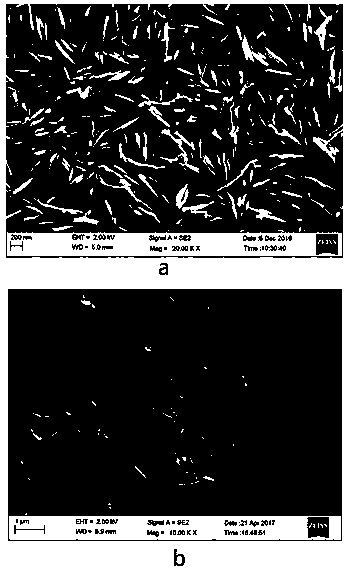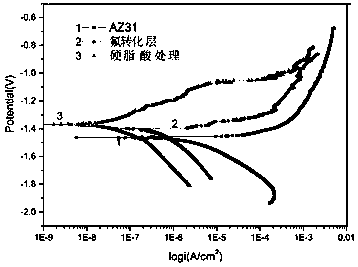A preparation method of superhydrophobic fluorine conversion coating on the surface of magnesium alloy
A technology of conversion coating and magnesium alloy, which is applied in the direction of metal material coating process, etc., can solve the problems of poor anti-corrosion performance and unsuitability for large-scale production, and achieve simple and easy-to-control equipment, low cost, and slow down the time of corrosion Effect
- Summary
- Abstract
- Description
- Claims
- Application Information
AI Technical Summary
Problems solved by technology
Method used
Image
Examples
Embodiment 1
[0034] 1) Clean and polish
[0035] Cut the magnesium alloy AZ31 into a sample of 15mm×1.5mm×2mm. There is a small hole with a diameter of 1mm at the corner of the sample, which can be tied with a thin wire for hanging in the experiment. Use SiC sandpaper (the roughness of the sandpaper is 200#, 400#, 600#, 800#, 1000#) to polish the sample in turn until the surface is smooth and no scratches can be seen with the naked eye. Clean it in an ultrasonic cleaner, then put it into the polishing solution (the volume ratio is HF:HNO 3 :H 2 O=1:10:89), take it out immediately after soaking for 5-10 seconds, rinse the surface with deionized water, dry it with a hair dryer, and set it aside.
[0036] 2) Preparation of micro / nanostructured fluorinated layer
[0037] Put the polished magnesium alloy sample of step 1) into a solvent bottle with a concentration of 40% hydrofluoric acid solution, seal the plastic wrap and wrap it with scotch tape, and soak for 7 days. After taking out the...
Embodiment 2
[0046] The morphology of the magnesium alloy coating prepared in Example 1 and Comparative Example 2 was observed with a Σ IGMA HDTM field emission scanning electron microscope (SEM) ( figure 1 ).
[0047] From figure 1 It can be seen that under SEM, a single fluorine conversion coating (comparative example 2) forms a sheet-like fluorine conversion crystal layer (such as figure 1 a), but there are many gaps between the crystals. And after further carrying out hydrophobic treatment on the fluorine conversion surface (embodiment 1), a superhydrophobic stearic acid film layer is formed on the fluorine conversion surface (such as figure 1 b), and the stearic acid film penetrates into the micro-nano structure fluorine conversion film layer, filling many gaps between the crystals, effectively preventing the solution from penetrating through the gaps of the film layer structure to cause corrosion of the substrate.
[0048] Use the Drop Meter A-100P surface and interfacial tens...
Embodiment 3
[0052] The electrochemical corrosion performance was tested by E G&G Model l273 electrochemical workstation. The measurement adopts a three-electrode system: the reference electrode is a saturated calomel electrode (SCE), the auxiliary electrode is a platinum electrode, and the working electrode is the sample to be tested. The corrosion medium is Hank's biomimetic solution with a pH of 7.4 (composition: NaCl: 8 g / l, KCl: 0.4 g / l, CaCl 2 :0.14 g / l, NaHCO 3 :0.35 g / l, C 6 h 6 o 6 : 1.0 g / l, MgCl 2 ·6H 2 O:0.1 g / l, MgSO 4 ·7H 2 O: 0.06 g / l, KH 2 PO4: 0.06 g / l, Na 2 HPO 4 12H 2 O: 0.06 g / l). The result is as image 3 shown.
[0053] From image 3 It can be seen from the figure that compared with the single fluorine conversion coating, the self-corrosion potential of the magnesium alloy sample with the fluorine conversion layer treated with stearic acid in Hank's solution is increased, the self-corrosion current density is reduced, and the damage The blunt potential...
PUM
 Login to View More
Login to View More Abstract
Description
Claims
Application Information
 Login to View More
Login to View More - R&D
- Intellectual Property
- Life Sciences
- Materials
- Tech Scout
- Unparalleled Data Quality
- Higher Quality Content
- 60% Fewer Hallucinations
Browse by: Latest US Patents, China's latest patents, Technical Efficacy Thesaurus, Application Domain, Technology Topic, Popular Technical Reports.
© 2025 PatSnap. All rights reserved.Legal|Privacy policy|Modern Slavery Act Transparency Statement|Sitemap|About US| Contact US: help@patsnap.com



